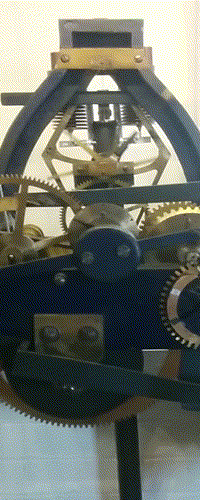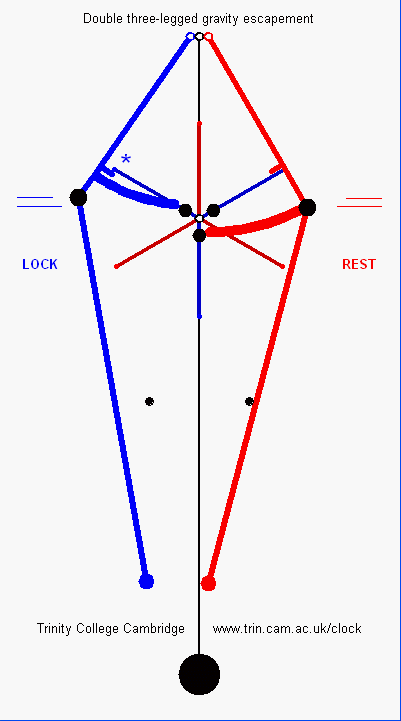

- 19 Dec 2010 [09:38]
- Bedmaker Effect, interim conclusion: 1: opening the door in the room below on a cold day causes the air flow in the pendulum chute to change (a cold downwards air flow is replaced by a warm upwards air flow) because of the chimney effect forced by the tall heated staircase in the building. 2: as the air warms up, the density and viscosity of the air both fall allowing the swing amplitude to increase. 3: The change in direction of air flow (downward to upward) causes the Going to drop (the clock slows down) because upward drag on the pendulum causes an apparent reduction in g.
- 19 Dec 2010 [09:37]
- Bedmaker Effect (continued) 2: the Going changes more dramatically [link] . What is interesting is that there is a step change in going of about -900ms/day and this occurs straight away, not at all related to the gradual temperature rise. This is clear in the scatter plot [link] (ok, there is a gradient at the expected slope due to thermal expansion, but this is after te initial step occurs. It was Dwight Elvey who made me look again at this, and I think he is right - the observed change in going could well be due to the change in air flow up the chute. If descending cold air is replaced by rising warmer air then the sudden change in direction of air flow will cause a change in Going. This has been looked at in the Theory section of the website, and in Section 4.6.4 and
- 19 Dec 2010 [09:36]
- estimate was calculated as -300ms/day per 1m/s of upward air flow. This suggests that the change in upward air flow this morning should have been around 3m/s - which is pretty fast. Certainly measurable. I will have to invest in a digital anemometer now!
- 19 Dec 2010 [09:36]
- Bedmaker Effect (continued) So, here are some observations: 1: amplitude changes linearly with temperature, as can be seen in a scatter plot [link] and the fact that the rise curve and the fall curve follow each other (ie there is no hysteresis) really suggests that the temperature sensor responds quickly to temperature change and that the amplitude measurement is due to air temperature change. The gradient is about 0.8mrad/C which agrees really well with theory for how drag varies with air density. Nothing definite yet, but the evidence for this theory is mounting.
- 19 Dec 2010 [09:35]
- Bedmaker Effect, just opening the door (no bedmaker!) on a cold morning, -4C outside. Heating on inside, really toasty. So, opening the door causes a chimney effect, forcing warm air into the pendulum chute. This temperature rise can now be seen [link] because the weather station is located in the pendulum chute itself. I have made some observations and these are in separate comments above.
- 18 Dec 2010 [12:00]
- It is good to see that the clock has settled down to where it was. [link]
- 18 Dec 2010 [12:01]
- Conclusion on temperature sensitivity of sensor: It seems that the sensor setup is not temperature sensitive over the range of temperature changes observed in the Bedmaker Effect (below 1C change). The key indicator is seen here [link] where the amplitude change when a hairdrier is blown onto the sensor is in the wrong direction.
- 18 Dec 2010 [09:39]
- Expt 3: [link] Now a hair drier is used to warm up the sensor, and at the same time part of the pendulum shaft is warmed up (it is not possible with a hair drier to target the sensor being so close to the pednulum shaft). We see that there is a small change in indicated amplitude, and this is downwards consistent with the negative temperature sensitivity of the sensor as found in expt 1. But most significant is a very large change in going (slope of the drift) to -1700ms/day. This is consistent with lengthening of the pendulum due to thermal expansion, and it is a large effect because the hair drier is quite hot.
- 18 Dec 2010 [09:33]
- Here [link] I bumped the pendulum while moving the temperature sensor into the pendulum chamber. The idea now is that the temperature indicated on the website is now the temperature inside the pendulum chamber rather than in the clock case.
- 18 Dec 2010 [09:21]
- Expt 2: [link] The same again, but the soldering iron is in place for about 5 minutes. This time there is a bigger effect on amplitude (about -0.2mrad) but again no significant effect on going. The thing to note is that the indicated amplitude change is negative, so that the effect of rising temperature is to reduce the indicated amplitude, but temperature change does not appreciably change the indicated rate of Going. The air temperature that the soldering iron produces around the sensor is HOT - very much higher than anything that the central heating will produce. It seems then that while the sensor is indeed temperature sensitive it cannot explain the Bedmaker Effect.
- 18 Dec 2010 [09:17]
- Experiments, in the light of helpful comments by Dwight Elvey who rightly points out that the optic sensor is probably temperature senitive. See [link] . Expt 1: placed a hot soldering iron under the sensor for about 30 seconds (wanting to warm up the sensor without warming up anything else). Note that the amplitude drops by about 0.05mrad while the going (slope of the drift) is unchanged.
- 17 Dec 2010 [09:05]
- It is good to see a prediction come true! Interesting to note, with a longer period of the door being open, that the amplitude looks to be increasing exponentially by about 0.4mrad at a time constant of about 20 minutes. The going does not show any decay - just a step of about -450ms/day. This reinforces the theory that the change in going is due to a change in length of the outer tube due to thermal expansion - corresponds to a temperature change of +1C. The puzzle to figure out now is a mechanism for the observed change in amplitude that corresponds to a change of +1C.
- 17 Dec 2010 [07:40]
- I asked the bedmaker to leave the door open for 20 minutes today [link] . Another concern: is the barometric compensator working [link] ? The blue data points should form a horizontal line - but they are following the -8ms/day per mbar lines exactly as we had before the compensator was installed.
Download data





